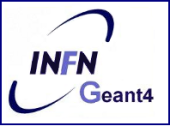Speaker
Description
Keymords
Neutron dosimeter, Geant4, validation.
Summary
The application of Si detectors with polyethylene converter for fast neutron personal dosimetry is well known [1]. An ideal dosimeter should be simply based on counting recoil protons only while the energy is independent for dose equivalent measurements. Adjustment of the energy response can be achieved by varying the thickness of the converter, however this is limited for a single detector [1].
Recent developments of Si pixelated detectors with multichannel readout chip coupled with a detector brought flexibility in design of neutron personal dosimeters. The novel approach, conceived at CMRP, consists of adding a converter of polyethylene on top of the sensitive volume of the pixelated Si detector device – Medipix2 [2, 3] - configured into segments with varying converter thickness.
A Geant4 simulation was developed to characterise the novel neutron dosimeter. In particular, the goal of the Geant4-based study is to optimize the number and thickness of the segments of Medipix2 polyethylene converter, to make the dosimeter energy independent for 0.3-15MeV neutrons in terms of counts/mSv.
The Geant4 simulation results were first compared to the theoretical predictions by Eisen et al. [1]), showing satisfactory agreement.
This activity is complemented with the validation of the Geant4 simulation with respect to experimental measurements, performed at ANSTO and CSIRO, where Medipix2 has been irradiated with three different neutron sources (14 MeV D-T neutron, Am-Be and Cf-252 source). Results with 14 MeV D-T neutron beam show a good agreement between Geant4 simulation results and experimental measurements. The validation activity is still on going for the Am-Be and Cf-252 sources.
First results of the optimization study of Medipix2 polyethylene converter will be shown as well.
References:
[1] Eisen, Y., Engler, G., Ovadia, E., Shamai, Y., Baum, Z. and Levi, Y.: A small size neutron and gamma dosemeter with a single silicon surface barrier detector. Radiat. Prot. Dosim. 15, 16, 1986.
[2] Llopart, X., Campbell, M., Dinapoli, R., San Segundo, D. and Pemigotti, E.: Medipix2: a 64-k pixel readout chip with 55-µm square elements working in single photon counting mode. IEEE Trans. Nucl. Sci. 49, 5, 2002.
[3] Llopart, X.: Design and characterization of 64K pixels chips working in single photon processing mode. (Sundsvall: Mid Sweden University), 2007.
| Are you a Memeber of the Geant4 Collaboration (yes/no) | yes |
|---|




